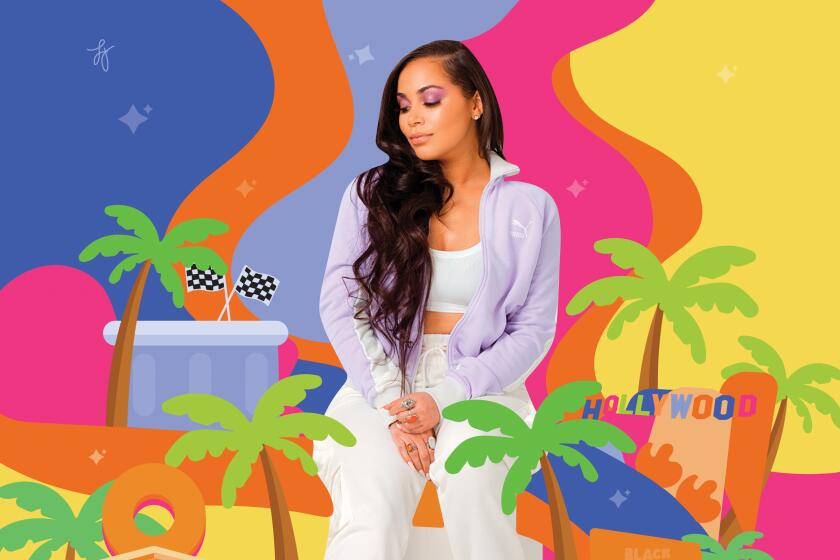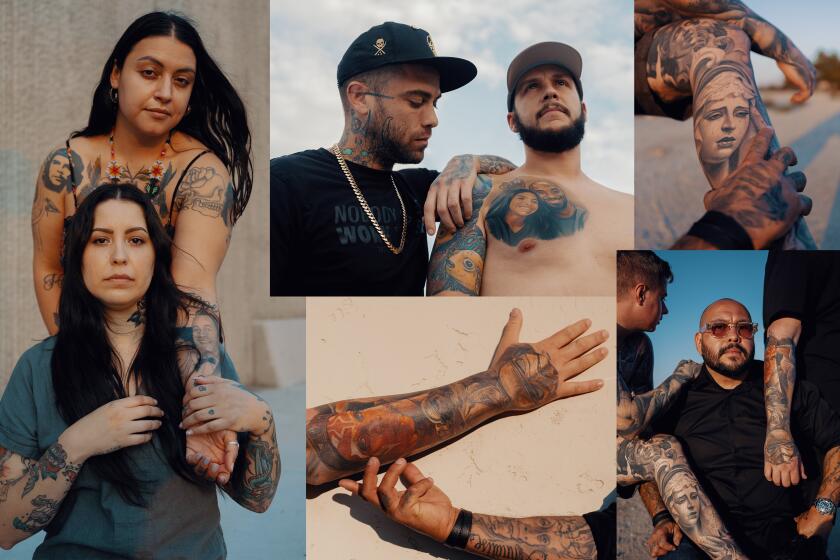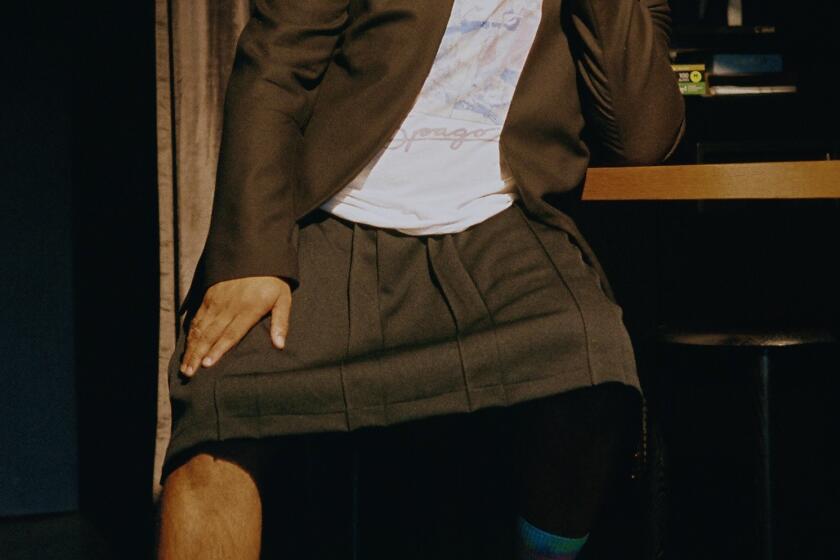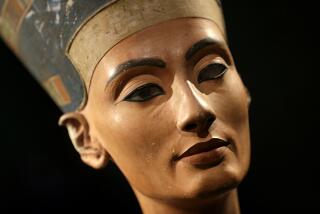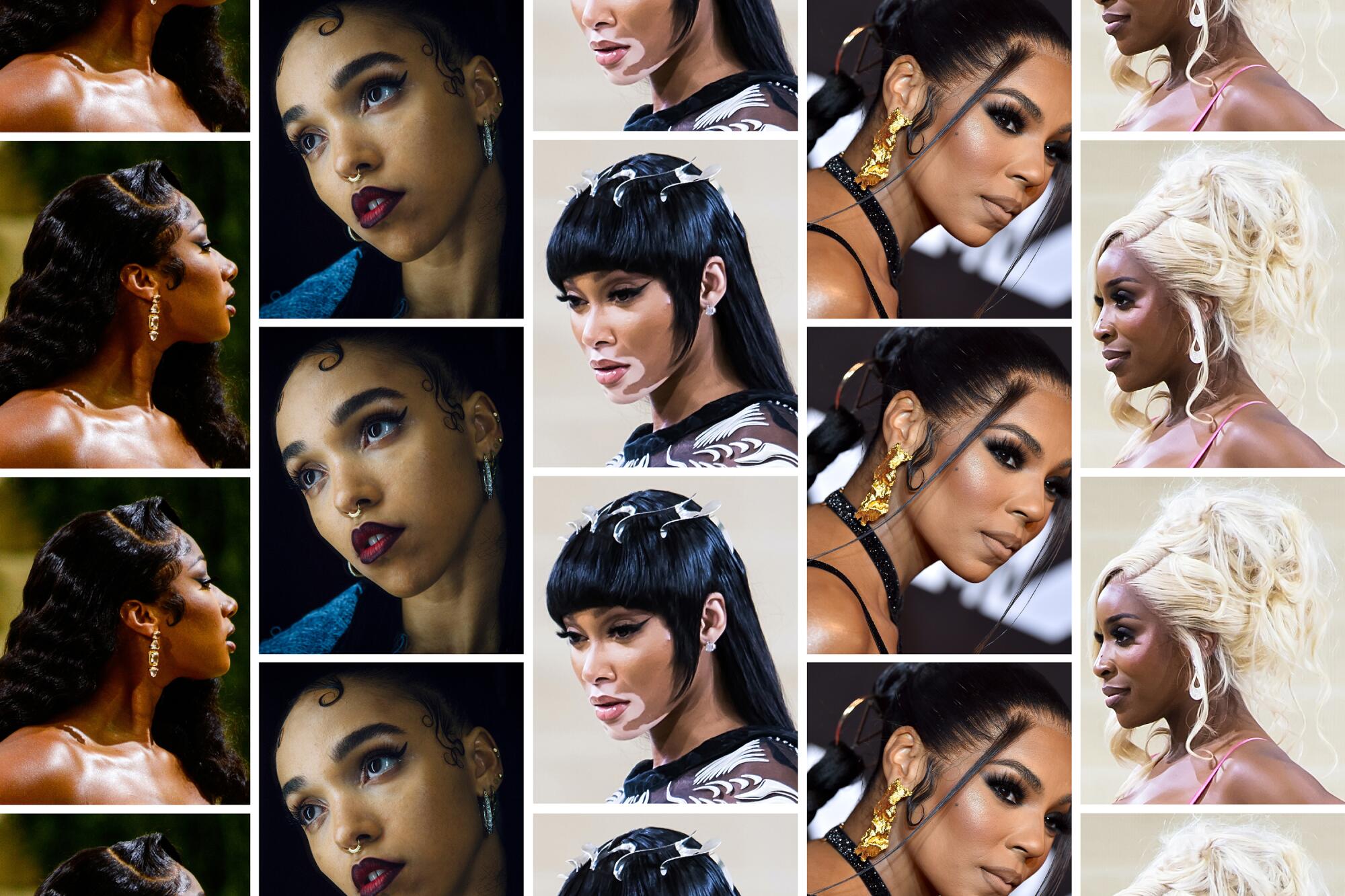
- Share via
This story is part of Image issue 5, “Reverence,” an exploration of how L.A. does beauty. See the full package here.
A few months ago, I noticed that the part of my hairline I’d been avoiding, relaxing, pushing, hiding, slicking back my entire life had quietly overtaken my timeline: sideburns. Suddenly, it seemed, the part of me I loathed growing up was ubiquitous; everywhere I swiped or double-tapped, there they were — sideburns being shaped with care and precision, sideburns being slicked down and swooped, sideburns at the very end of the wig transformation videos I devoured.
Never had I seen sideburns styled so prominently on my feeds and given this kind of love — brushed forward and meant to be seen. The cinematography highlighted the levels: Camera angles — close pans and crops — emphasized the elongation of the hair. Loose strands, under careful edit, appeared cut and glued, creating the effect of a fuller, wispier sideburn. Hair, gelled down and brushed, was delicately rendered as a single curl.
Hair is an exercise in alteration, customization. Color, style, form, texture — there’s no limit, really. Over the years, baby hair has taken center stage as a playground for swirling and adorning the hairline. But sideburns were a kind of hairline playing field not always taken into account. Their neglect is surprising when you see their power in action.
Sideburns carry an attitude. The cover art for last year’s Megan Thee Stallion and Cardi B sex-rap banger “WAP” is punctuated by the displays of their facial profiles. Their ’90s updos might have stolen the show (another era when sideburns were styled prominently), but their simple sideburns, brushed down, are a reminder of how important sideburns are, ornate or not.
Lauren London reflects on acting, Nipsey Hussle, Black L.A.
The finishing touch of sideburn styling is crucial in framing the face. Short or long, we’re all working with a version of a sideburn as part of our hairlines (isn’t that what we’re all trying to hold on to?). Sideburns are egalitarian. So why do they feel like such a nuisance?
Growing up, I never showed my sideburns any love. It didn’t matter how I wore them; I never knew what to do with them. Sometimes they lay flush against the face. Other times, they appeared curly, straight, kinky. Barely long enough to tuck behind my ear and too short to slick down, they never got the memo about utility.
I never shaved my sideburns growing up but it’s a wonder I never tried. Even with braided styles, my biggest request to my stylist was to put as much of my sideburn hair into a single braid as possible. When tiny Afro puffs would take shape alongside my cheekbones, I‘d start to roll my eyes. What am I supposed to do with these? Time to pull out the gel. They were curly and short but thankfully not too noticeable — until I was called out for them.
Image Reverence stories
Mr. Wash remembers that time Drake slid into his DMs
Julissa James unpacks the art of putting someone’s face on your body
Dave Schilling learns what it means to be beautiful in Comme Des Garçons
Jean Chen Ho explores grief through IG thirst traps
Texas Isaiah shows how photography doesn’t have to perpetuate visual violence
“Whatever, Ashanti.” I still remember the dig. Me, Ashanti. The 2002 platinum recording artist and Grammy Award-winning R&B singer and songwriter, who felt omnipresent in my world during my adolescence. Ashanti. Was. Literally. Everywhere: “Always on Time,” alongside rapper Ja Rule, “What’s Luv?” and “Foolish.” She was that girl. I was 12 years old, and for preteen Black girls like me, who had baby hair and sideburns, her name became a last-word insult. Middle school is all about one-liners. I received them — typically from the few Black boys I went to school with in a suburb outside of Buffalo. I wondered about the mechanics of the snub. There was always this undertone — intentional or implied — that sideburns were masculine and, therefore, something women should not want, or have.
I grew annoyed that I had them. Since sideburns often are categorized as facial hair, I felt — like many women — that my sideburns were something to get rid of. Even now, the great majority of YouTube videos I’ve seen focusing on women and sideburns fixate on how to shave them with a dermaplaner or use waxing strips on them.
Lila Robles is one of the most celebrated nail artists on the internet. You’ll leave her Highland Park studio feeling nostalgic and fiiiiiiiiiiiine
Sideburns are detailed in portraits as a symbol of authority — usually for men — in various cultures. In earlier eras, men were encouraged to develop and preserve their sideburns or shape them into a style that would prove one’s hairiness. Big, wide sideburns were stylish in the ’60s; in vintage photos on Tumblr, Paul McCartney shows up next to guys with skinny jeans who look like they‘d live in Highland Park.
Knowing there is power to be found in the hairs on the side of my face is something I’m learning to embrace. I’m thankful for this recent influx of women reflecting their confidence through their sideburns. And I’m thankful for the way in which wigs are summoning this power in creative ways. Sideburns can enhance the shape of your face or call attention to your best features. They can help to create a distinct “you” or send a message — whatever that may be. Perhaps the artifice of sideburns on wigs points to a future where we can abandon the foolishness of hiding what’s been there all along.
Darian Symoné Harvin is a beauty and culture writer. She was born in Long Beach, Calif., grew up in Buffalo, N.Y., and lives in Los Angeles.
